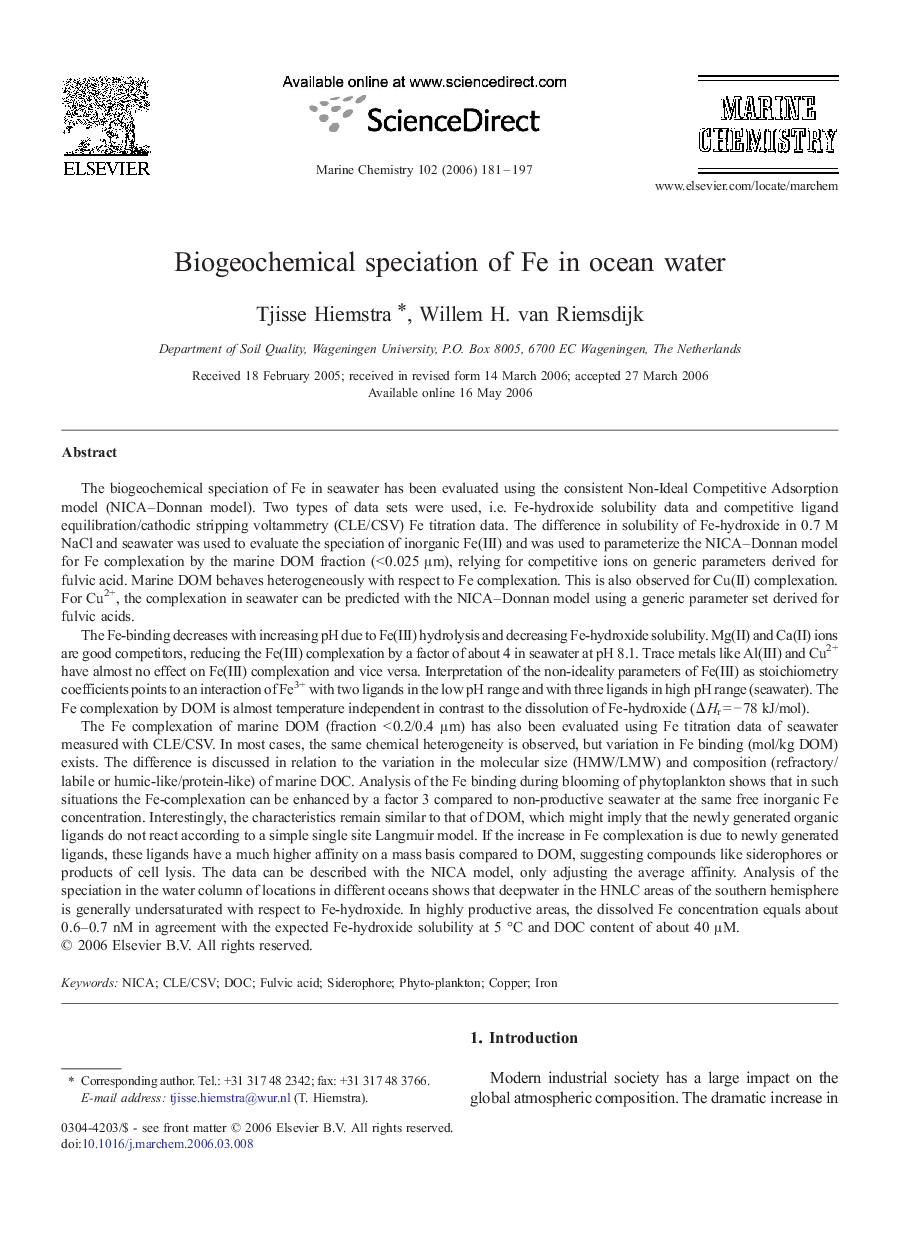| کد مقاله | کد نشریه | سال انتشار | مقاله انگلیسی | نسخه تمام متن |
|---|---|---|---|---|
| 1263526 | 1496734 | 2006 | 17 صفحه PDF | دانلود رایگان |

The biogeochemical speciation of Fe in seawater has been evaluated using the consistent Non-Ideal Competitive Adsorption model (NICA–Donnan model). Two types of data sets were used, i.e. Fe-hydroxide solubility data and competitive ligand equilibration/cathodic stripping voltammetry (CLE/CSV) Fe titration data. The difference in solubility of Fe-hydroxide in 0.7 M NaCl and seawater was used to evaluate the speciation of inorganic Fe(III) and was used to parameterize the NICA–Donnan model for Fe complexation by the marine DOM fraction (< 0.025 μm), relying for competitive ions on generic parameters derived for fulvic acid. Marine DOM behaves heterogeneously with respect to Fe complexation. This is also observed for Cu(II) complexation. For Cu2+, the complexation in seawater can be predicted with the NICA–Donnan model using a generic parameter set derived for fulvic acids.The Fe-binding decreases with increasing pH due to Fe(III) hydrolysis and decreasing Fe-hydroxide solubility. Mg(II) and Ca(II) ions are good competitors, reducing the Fe(III) complexation by a factor of about 4 in seawater at pH 8.1. Trace metals like Al(III) and Cu2+ have almost no effect on Fe(III) complexation and vice versa. Interpretation of the non-ideality parameters of Fe(III) as stoichiometry coefficients points to an interaction of Fe3+ with two ligands in the low pH range and with three ligands in high pH range (seawater). The Fe complexation by DOM is almost temperature independent in contrast to the dissolution of Fe-hydroxide (ΔHr = − 78 kJ/mol).The Fe complexation of marine DOM (fraction < 0.2/0.4 μm) has also been evaluated using Fe titration data of seawater measured with CLE/CSV. In most cases, the same chemical heterogeneity is observed, but variation in Fe binding (mol/kg DOM) exists. The difference is discussed in relation to the variation in the molecular size (HMW/LMW) and composition (refractory/labile or humic-like/protein-like) of marine DOC. Analysis of the Fe binding during blooming of phytoplankton shows that in such situations the Fe-complexation can be enhanced by a factor 3 compared to non-productive seawater at the same free inorganic Fe concentration. Interestingly, the characteristics remain similar to that of DOM, which might imply that the newly generated organic ligands do not react according to a simple single site Langmuir model. If the increase in Fe complexation is due to newly generated ligands, these ligands have a much higher affinity on a mass basis compared to DOM, suggesting compounds like siderophores or products of cell lysis. The data can be described with the NICA model, only adjusting the average affinity. Analysis of the speciation in the water column of locations in different oceans shows that deepwater in the HNLC areas of the southern hemisphere is generally undersaturated with respect to Fe-hydroxide. In highly productive areas, the dissolved Fe concentration equals about 0.6–0.7 nM in agreement with the expected Fe-hydroxide solubility at 5 °C and DOC content of about 40 μM.
Journal: Marine Chemistry - Volume 102, Issues 3–4, 5 December 2006, Pages 181–197